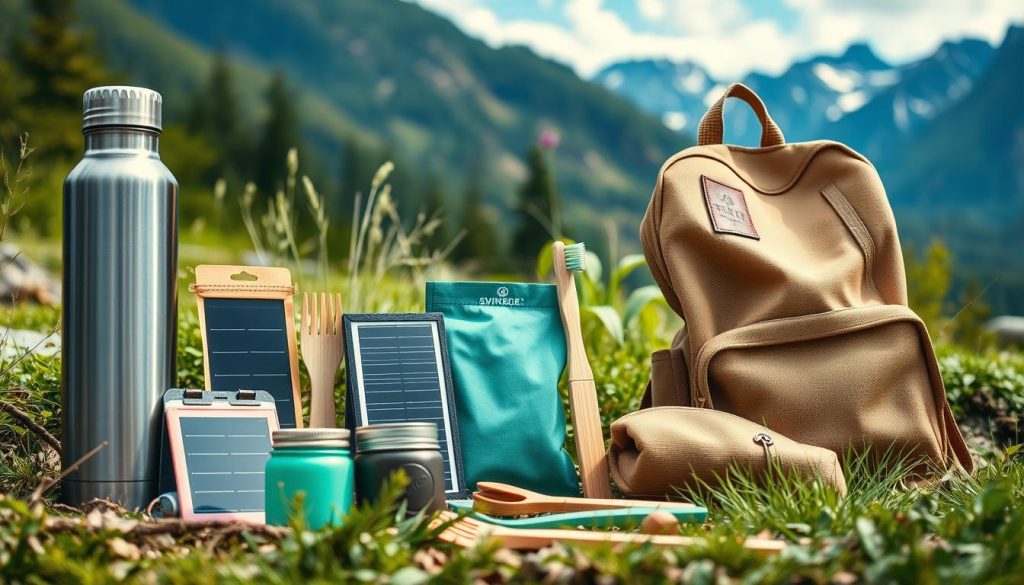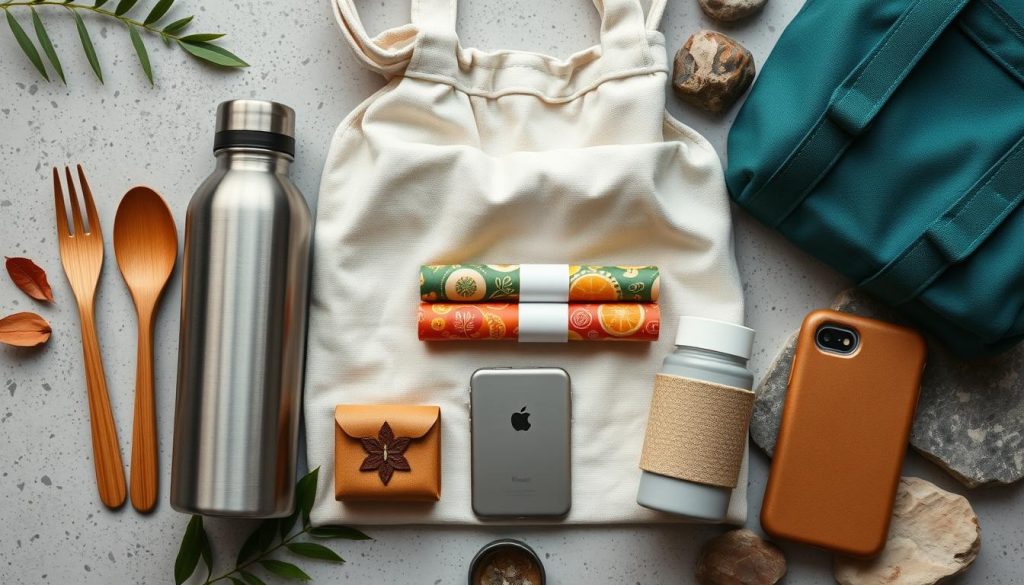I love exploring new places, but I’ve started thinking about how I impact the environment. That’s why I’ve taken up zero waste travel. It lets me see the world while keeping it green.
Discovering ways to travel without waste has been exciting. It’s all about the little things, like using reusable items and staying in eco-friendly places. These changes help a lot.
Let’s dive into the world of zero waste travel together. We can make our trips better for the planet and ourselves. It’s all about finding balance between adventure and care for the earth.
Embracing the Zero Waste Travel Lifestyle
Zero waste travel is a big change for those who love to explore the world in a responsible way. It’s more than just being eco-friendly; it’s about cutting down on waste while we travel. I’m excited to share how we can make a difference and still enjoy our travels.
Understanding Zero Waste Travel
Zero waste travel means we avoid single-use items and choose reusable ones instead. It’s about making choices that help the planet. From carrying less to supporting local places, every choice helps make our travels better for the environment.
Benefits of Eco-Friendly Adventures
Choosing zero waste travel has many benefits:
- It reduces our impact on the environment
- It saves money by avoiding unnecessary buys
- It helps us connect more with local people
- It makes our cultural experiences richer
- It helps us grow personally and be more mindful
Setting Realistic Goals
Changing to zero waste travel takes time. Setting goals that are achievable helps us stay on track. Here’s a simple guide to start:
| Goal Level | Action Items | Impact |
|---|---|---|
| Beginner | Bring a reusable water bottle and shopping bag | Reduce plastic waste |
| Intermediate | Use plastic-free toiletries and eco-friendly places to stay | Lower carbon footprint |
| Advanced | Choose green ways to travel and support local green projects | Help sustainable tourism grow |
By slowly adding these habits, we can make a big difference in our travels. Remember, every little bit helps our planet and the places we visit.
Essential Gear for Sustainable Explorers

Getting ready for my plastic-free travel, I found amazing gear for minimal waste trips. Packing right is crucial to lessen our impact on the environment while seeing the world.
My top picks for green travel are:
- Reusable water bottle
- Collapsible food containers
- Bamboo cutlery set
- Cloth shopping bags
- Stainless steel straws
I’ve replaced disposable plastics with these long-lasting options. This makes drinking water and eating on the move easy without waste. For toiletries, I choose solid shampoo bars, toothpaste tablets, and sunscreen safe for reefs to cut down on packaging and protect oceans.
Choosing clothes wisely is important for eco-friendly travelers. I pack items that are versatile, dry fast, and made from organic or recycled materials. This not only lightens my bag but also supports brands that care for the planet.
By choosing quality, versatile gear, I’ve made my packing list simpler and adopted a greener travel way. These smart choices have made my trips better, letting me see new places without harming our planet.
Planning Your Low-Impact Itinerary

When I plan my low-impact travel, I aim to leave a small environmental footprint. This way, I can explore new places while supporting green travel. Let’s look at the main steps for planning an eco-friendly trip.
Researching eco-friendly destinations
I begin by searching for destinations known for their green efforts. Countries like Costa Rica, Slovenia, and New Zealand are great examples. I look for places with strong environmental policies and protected natural areas.
Choosing sustainable accommodations
Choosing the right place to stay is key for a low-impact trip. I seek out eco-lodges, green hotels, and sustainable guesthouses. These places use renewable energy and support local communities.
Opting for green transportation methods
Transportation is a big part of my carbon footprint. So, I choose green options. I prefer trains over planes for long trips. In cities, I use public transit or walk to explore.
| Transportation Method | Carbon Footprint (kg CO2 per passenger mile) | Benefits |
|---|---|---|
| Walking | 0 | Zero emissions, exercise, intimate city experience |
| Cycling | 0 | Zero emissions, exercise, flexible exploration |
| Train | 0.14 | Low emissions, scenic routes, comfortable for long distances |
| Bus | 0.18 | Low emissions, cost-effective, extensive route networks |
| Car (average) | 0.41 | Flexibility, convenience for remote areas |
| Airplane | 0.62 | Speed for long distances, necessary for some destinations |
Packing Light and Smart: The Minimalist Approach
Starting with smart packing is key to minimal waste vacations. A minimalist approach cuts down on waste and makes travel better. It means packing only what’s essential, making travel lighter and more enjoyable.
Creating a versatile wardrobe is crucial. I pick clothes that can be mixed and matched. This way, I carry fewer items but still have variety in my outfits. Quick-dry fabrics let me wash clothes easily, reducing the need for extra items.
Multi-purpose items are essential for minimal waste travel. A sarong, for example, can be a beach cover-up, picnic blanket, or even a makeshift bag. Choosing items with multiple uses saves space and boosts functionality.
Digital alternatives are vital for conscious travel. I keep documents and books digital instead of printing them. E-books and mobile apps replace heavy books and bulky guidebooks. This reduces paper waste and lightens my load.
| Item | Traditional Packing | Minimalist Approach |
|---|---|---|
| Clothes | 10-15 outfits | 5-7 versatile pieces |
| Books | 2-3 physical books | E-reader or smartphone app |
| Toiletries | Full-size bottles | Reusable travel containers |
| Travel Documents | Printed copies | Digital copies on smartphone |
Using these minimalist packing tips makes my travels better and greener. It’s a simple way to travel more consciously and reduce waste.
Zero Waste Travel: Tips for Reducing Plastic Use on the Go

Zero waste travel is a big step for those who care about the planet. With a few easy steps, we can cut down our plastic use while traveling. Here are some tips to make your trips greener and more fun.
Bringing reusable containers and utensils
I always carry reusable items in my bag. This includes a water bottle, coffee mug, food container, and bamboo cutlery. They’re perfect for eating out, picnics, and staying hydrated without plastic.
Finding plastic-free alternatives for toiletries
Switching to solid toiletries has changed my travel game. I use shampoo bars, solid deodorant, and toothpaste tablets. These options cut down waste and save space in my luggage. For sunscreen and moisturizer, I choose metal tins or glass jars.
Strategies for avoiding single-use plastics
To really go plastic-free, I follow these tips:
- Carry a reusable shopping bag for souvenirs and groceries
- Say no to plastic straws and bring a metal or bamboo alternative
- Choose accommodations that prioritize sustainability
- Support local markets and vendors who use minimal packaging
By using these strategies, I’ve found zero waste travel is not only doable but also fulfilling. It lets me see new places while helping the environment.
Eco-Friendly Dining: Savoring Local Flavors Responsibly
Traveling and dining out can be a fun way to support sustainable tourism. I choose restaurants that care about the environment. This way, I enjoy local tastes while helping the planet.
I always look for places that use local ingredients. This cuts down on emissions and boosts the local economy. It’s a win-win for everyone.
To cut down on waste, I bring my own container for leftovers. This simple step helps avoid plastic waste and food that’s thrown away. I also try to order just the right amount of food.
Telling restaurants I don’t want straws or extra garnishes is easy now. Many places are happy to accommodate these requests. They see it as a sign of appreciation for their sustainable efforts.
- Choose restaurants with farm-to-table concepts
- Opt for seasonal menu items to support local agriculture
- Try plant-based dishes to reduce your carbon footprint
Embracing these habits has made my travels better. It lets me connect with local cultures and help preserve the places I visit. Making conscious food choices is a small step towards a bigger change.
Navigating Transportation: Green Ways to Explore
Green travel is more than just where you go. It’s also about how you get there. Exploring with eco-friendly transport is an adventure. Let’s look at some low-impact travel options to see the world while reducing our carbon footprint.
Utilizing public transit systems
Public transport is my top choice for green travel. Buses and trains are affordable and good for the planet. I enjoy taking a local bus to feel the city’s vibe. It’s like a mini-tour that shows hidden spots and lets me meet locals.
Embracing bike-sharing programs
Bike-sharing is a fun way to see cities. Many cities have easy bike rental systems. Cycling lets me see more than walking, while still enjoying the views. Plus, it’s a great way to stay fit!
Walking tours: The ultimate low-impact option
Walking is the greenest travel choice. I often join guided tours or make my own paths. It’s great for immersing in a place’s atmosphere. You can pause to take photos, talk to locals, or try street food.
| Transport Method | Environmental Impact | Exploration Level |
|---|---|---|
| Public Transit | Low | Medium |
| Bike-sharing | Very Low | High |
| Walking | None | Very High |
Choosing green travel options reduces our environmental impact. It also offers unique experiences and a deeper connection with our destinations. So, when planning a trip, think about making your journey as exciting as your destination!
Responsible Tourism: Supporting Local Communities
When I travel, I focus on responsible tourism. This means supporting local communities and traveling with care. It makes my trips better and helps the places I visit.
Shopping at local markets is a great way to support communities. These markets show the real culture and let you buy unique items from artisans. I enjoy talking to vendors and learning about their crafts.
Community-based tourism is another excellent choice. It includes homestays, tours with locals, and workshops. These experiences help the community and keep traditions alive.
I also choose locally-owned places to stay and tour. This supports the local economy and gives me real experiences. Family-run places and small tours offer better service and knowledge.
| Responsible Tourism Actions | Benefits to Local Communities |
|---|---|
| Shopping at local markets | Supports local artisans and small businesses |
| Participating in community-based tourism | Preserves traditions and provides direct income |
| Choosing locally-owned accommodations | Boosts local economy and creates jobs |
| Opting for local tour operators | Ensures tourism profits stay within the community |
Embracing these practices makes my travels more rewarding. It helps keep local cultures and environments alive. It’s a way to make every trip count.
Digital Nomad’s Guide to Environmentally-Friendly Travel
As a digital nomad, I’ve learned to mix work and travel while caring for the planet. I’ve made green travel a habit. Here are some tips to reduce your carbon footprint while traveling.
Minimizing electronic waste
I always carry a versatile power bank and a universal adapter. This cuts down on the need for many chargers. I choose refurbished devices or trade in old ones. This helps reduce electronic waste and supports the circular economy.
Eco-friendly work habits while on the road
My work habits are green too. I use energy-saving settings on my devices and prefer offline work when I can. Cloud storage keeps me paperless, and I’ve switched to digital business cards to avoid waste. These small steps make my work more sustainable.
Choosing green co-working spaces
Finding eco-friendly workspaces is crucial for me. I look for co-working spaces that use renewable energy and recycle. These spaces inspire me to stay green and connect with others who care about the environment.

